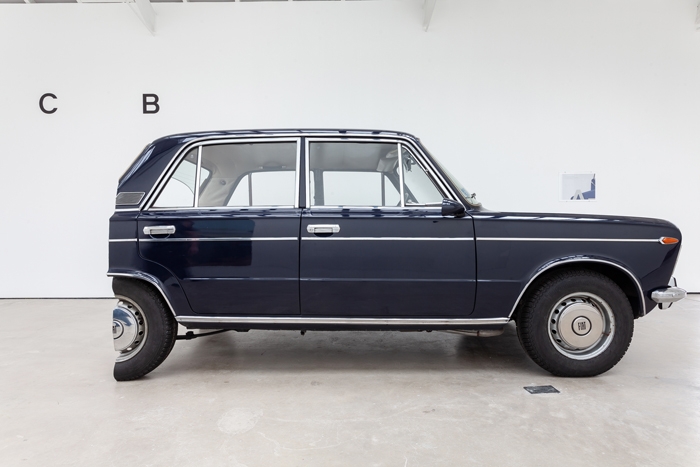Because a painting by Rococo master Giovanni Battista Tiepolo (The Finding of Moses, c. 1730) was once cut into two separate paintings, a 1968 Fiat 125 Special has been cut into two unequal pieces. The smaller of the two parts of the Tiepolo painting (representing a proud halberdier, afterwards known as A Halberdier in a Landscape) is present in lifesize reproduction, on the gallery wall. Where the rest of the painting would be is a sheet of clear acrylic, cut to the same size as the absent painting. Aligned to the vertical division between the two parts of the Tiepolo painting, the Fiat 125 has been sliced through, the rear part removed, leaving its internal spaces and surfaces open to view: down through the rear window, the section cleaves past the faded upholstered burgundy of the rear seating and into the grey vinyl lining of the booth, and then down through the rear axle and tyres. Because Simon Starling’s show A-A’, B-B’ consists of two parts – the first show here in Glasgow and the other directly following it at Galleria Franco Noero in Turin (home, also, of the Fiat car company) – the Turin show will present the absent portions of the painting and the car.
Simon Starling’s show A-A’, B-B’ is a tangle of improbable connections. Starling’s cut dramatises distance, across space and time, joining things and events through history, in fortuitous, wilful associative leaps. Because what connects the painting by Tiepolo and the Fiat is, so the notes tell us, that the painting was once owned by another Giovanni – the fabulously wealthy Italian industrialist Giovanni Agnelli and owner of Fiat, who, local legend has it, used to make a point of driving around Turin in his own standard-model navy blue 125.
Stitching together the sundered Tiepolo with the act of chopping up an antique Italian car would be a whimsical gesture, if it ended there. But Starling leads us on, Pied Piper-like, to the text of playwright Dario Fo’s 1981 play Trumpets and Raspberries, a political satire in which Agnelli is kidnapped, badly disfigured in a car crash and then mistaken for an ordinary Fiat factory worker, Alberto. A copy of Trumpets is present nearby, held in the gloved hand of a rebar-metal mannequin whose head is made of a Japanese Noh theatre mask in the likeness of Agnelli, which, hollow-eyed, gazes at the text with an air of puzzlement.
Starling’s playful, connect-the-dots method generates these idiosyncratic, exquisitely produced artefacts, which are tied together by nothing more than the pleasure of finding (or making) these unlooked-for associations. The work, if it exists anywhere, is in this constellation of artefacts, facts and events, which Starling here stretches from Scotland to Italy (since, in another happy coincidence, The Finding of Moses happens to be in the collection of the Scottish National Gallery in Edinburgh). Art becomes a portal back into the history of art’s entanglements with society – a recurring theme in Starling’s work, as with his 2010 Project for a Masquerade (Hiroshima): The Mirror Room, which traced its way through Cold War history and the making of the atom bomb, by way of a Henry Moore sculpture produced first for Chicago and then Hiroshima, in which the key historical protagonists figure as Noh masks.
Masks and masquerade are the other axis of A-A’, B-B’: in the Noh mask-renderings of Agnelli, and another interpreting the face of Tiepolo’s Halberdier; in the scene lifted from Fo’s play, which dwells on the bandaged face of Agnelli following his injuries; in Agnelli’s reputed habit of driving his own ordinary 125 in Turin – motivated, perhaps, by the desire for anonymity when political kidnappings were a frequent event in Italy during the 1970s; and a kind of theatricality and artifice underpins Tiepolo’s absurdly fashionable rendering of The Finding of Moses, as the Biblical characters of Ancient Egypt are presented as sumptuously dressed European aristocrats and their servants.
Social class, then, is tangled in this present masquerade, though it’s hard to conclude that Starling presents this as overt comment or critique. As a dramatic device, the transgressing of social-class boundaries through mistaken identity has long roots, going back, for example, to Shakespearean comedies like Twelfth Night (1602). In the end, though, class order is always restored. Baroque and Rococo art never got far past aristocratic self-regard.
Still, if it makes no comment, A-A’, B-B’ sets these questions up for a fall. Picking up on the greyhounds depicted in Tiepolo’s painting, Starling has taken pains to photograph pedigree greyhounds in a photography studio in Turin habitually used for the photographing of cars. Racing dogs with an ambiguous relationship to privilege, greyhounds were once the preserve of nobility, later to become a working-class sporting pastime.
This transposition of identities and perspectives is something artists – having a foot in opposing camps, so to speak – are often best place to articulate. This is perhaps what also underpins Starling’s opposition of industrial manufacture and artisan handmaking that inflects much of this show (and the associated minishow by Zürich-based graphic designers Norm, who present a project based on their discovery of a graphic design rebranding proposal for a now-untraceable Italian industrial concern, sometime during the 1970s). Ultimately, beyond any more-direct political and historical agency, it’s the nature of the artist as a kind of nomadic, self-authorising reinventor of historical space, and of art’s unstable appearance and reappearance within it, that A-A’, B-B’ claims as its subject.
Simon Starling: A-A’, B-B’ at The Modern Institute, Glasgow, through 26 October
From the October 2019 issue of ArtReview
